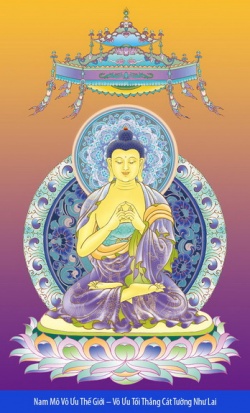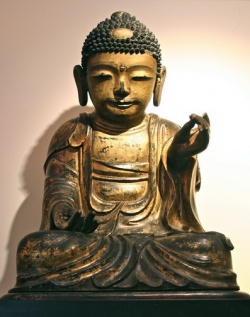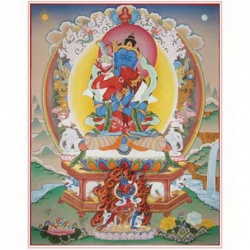Difference between revisions of "Four tenet systems"
| Line 1: | Line 1: | ||
{{DisplayImages|827|1207|1918|408|713}} | {{DisplayImages|827|1207|1918|408|713}} | ||
| + | |||
| + | |||
| + | |||
| + | |||
| + | |||
| + | |||
| + | |||
[[Four tenet systems]] — in the [[Indian]] [[Mahayana]] [[Buddhist]] [[monasteries]], such as [[Nalanda]], [[monks]] studied four systems of [[Buddhist]] {{Wiki|tenets}}. These systems are: | [[Four tenet systems]] — in the [[Indian]] [[Mahayana]] [[Buddhist]] [[monasteries]], such as [[Nalanda]], [[monks]] studied four systems of [[Buddhist]] {{Wiki|tenets}}. These systems are: | ||
| Line 9: | Line 16: | ||
The [[Tibetans]] have followed this {{Wiki|custom}}, but have made further subdivisions within these four systems. For example, within [[Madhyamaka]], they have differentiated [[Svatantrika]] [[Madhyamaka]] from [[Prasangika]] [[Madhyamaka]]. Within [[Svatantrika]] [[Madhyamaka]], the [[Gelug]] school has further classified [[Indian]] authors as [[Yogachara]] [[Svatantrika]] or [[Sautrantika]] [[Svatantrika]]. The various non-Gelug schools have subdivided [[Madhyamaka]] in yet other ways. | The [[Tibetans]] have followed this {{Wiki|custom}}, but have made further subdivisions within these four systems. For example, within [[Madhyamaka]], they have differentiated [[Svatantrika]] [[Madhyamaka]] from [[Prasangika]] [[Madhyamaka]]. Within [[Svatantrika]] [[Madhyamaka]], the [[Gelug]] school has further classified [[Indian]] authors as [[Yogachara]] [[Svatantrika]] or [[Sautrantika]] [[Svatantrika]]. The various non-Gelug schools have subdivided [[Madhyamaka]] in yet other ways. | ||
| − | ==Major Authors and Texts== | + | ==Major Authors and [[Texts]]== |
'''[[Vaibhashika]]''' | '''[[Vaibhashika]]''' | ||
:*[[Vasubandhu]] (400-480) | :*[[Vasubandhu]] (400-480) | ||
| Line 34: | Line 41: | ||
::*[[Abhisamayalankara]] | ::*[[Abhisamayalankara]] | ||
| − | ''[[Prasangika-Madhyamaka]]'' is studied primarily through the works of [[Chandrakirti]] ([[Zla-ba grags-pa]]), [[Aryadeva]] (‘[[Phags-pa lha]]), [[Shantideva]] ([[Zhi-ba]] lha), and [[Buddhapalita]] (Sang-rgyas bskyangs). | + | ''[[Prasangika-Madhyamaka]]'' is studied primarily through the works of [[Chandrakirti]] ([[Zla-ba grags-pa]]), [[Aryadeva]] (‘[[Phags-pa lha]]), [[Shantideva]] ([[Zhi-ba]] [[lha]]), and [[Buddhapalita]] (Sang-rgyas bskyangs). |
:*[[Chandrakirti]] | :*[[Chandrakirti]] | ||
| Line 46: | Line 53: | ||
::*[[Mulamadhyamaka-vrtti-buddhapalita]] – a commentary to [[Nagarjuna’s]] [[Mulamadhyamaka-karika]] | ::*[[Mulamadhyamaka-vrtti-buddhapalita]] – a commentary to [[Nagarjuna’s]] [[Mulamadhyamaka-karika]] | ||
| − | Other proponents of this tenet system are: | + | Other proponents of this [[tenet]] system are: |
:*[[Patsab Nyima Drak]] (1055-1145) – translated [[Chandrakirti]] into [[Tibetan]] | :*[[Patsab Nyima Drak]] (1055-1145) – translated [[Chandrakirti]] into [[Tibetan]] | ||
:*[[Tsongkhapa]] (1357-1419) – wrote a commentary on the [[Madhyamakavatara]] | :*[[Tsongkhapa]] (1357-1419) – wrote a commentary on the [[Madhyamakavatara]] | ||
| Line 63: | Line 70: | ||
::*[[Sphutartha]] – a commentary to [[Maitreya’s]] “Ornament of Realizations” | ::*[[Sphutartha]] – a commentary to [[Maitreya’s]] “Ornament of Realizations” | ||
| − | Other proponents of this tenet system are: | + | Other proponents of this [[tenet]] system are: |
:*[[Ngok Loden Sherab]] (1059-1109) | :*[[Ngok Loden Sherab]] (1059-1109) | ||
:*[[Chapa Chökyi Sengé]] (1109-1169) – composed the first [[Tibetan]] summary of of [[Dharmakirti’s]] [[thought]]. | :*[[Chapa Chökyi Sengé]] (1109-1169) – composed the first [[Tibetan]] summary of of [[Dharmakirti’s]] [[thought]]. | ||
| Line 73: | Line 80: | ||
:*[[Bhavaviveka]] | :*[[Bhavaviveka]] | ||
::*[[Madhyamaka-hrdaya]] | ::*[[Madhyamaka-hrdaya]] | ||
| − | ::*[[Tarkajvala]] ([[Wyl.]] ''rTog-ge ‘bar-ba''), Blaze of {{Wiki|Reasoning}}; an autocommentary on Madhyamaka-hrdaya | + | ::*[[Tarkajvala]] ([[Wyl.]] ''rTog-ge ‘bar-ba''), Blaze of {{Wiki|Reasoning}}; an autocommentary on [[Madhyamaka-hrdaya]] |
==Further Reading=={{Nolinking|*[[Khenpo Tsultrim Gyamtso Rinpoche]], ''Progressive Stages of Meditation on Emptiness'', translated and arranged by Shenpen Hookham (Ithaca NY: Snow Lion Publications 2000). | ==Further Reading=={{Nolinking|*[[Khenpo Tsultrim Gyamtso Rinpoche]], ''Progressive Stages of Meditation on Emptiness'', translated and arranged by Shenpen Hookham (Ithaca NY: Snow Lion Publications 2000). | ||
Revision as of 08:28, 4 February 2016
Four tenet systems — in the Indian Mahayana Buddhist monasteries, such as Nalanda, monks studied four systems of Buddhist tenets. These systems are:
The Tibetans have followed this custom, but have made further subdivisions within these four systems. For example, within Madhyamaka, they have differentiated Svatantrika Madhyamaka from Prasangika Madhyamaka. Within Svatantrika Madhyamaka, the Gelug school has further classified Indian authors as Yogachara Svatantrika or Sautrantika Svatantrika. The various non-Gelug schools have subdivided Madhyamaka in yet other ways.
Major Authors and Texts
- Vasubandhu (400-480)
- Dignaga (circa 6th century)
- Dharmakirti (7th Century)
- Seven Treatises on Valid Cognition – a detailed commentary on the work of Dignaga
Chittamatra (or Yogachara)
- Nagarjuna (circa 150-250)
Two Divisions of Madhyamaka
Svatantrika-Madhyamaka is studied in general in the context of far-reaching discriminating awareness (Wyl. phar-phyin, Skt. prajnaparamita, perfection of wisdom), as formulated by Maitreya.
Prasangika-Madhyamaka is studied primarily through the works of Chandrakirti (Zla-ba grags-pa), Aryadeva (‘Phags-pa lha), Shantideva (Zhi-ba lha), and Buddhapalita (Sang-rgyas bskyangs).
-
- Madhyamakavatara – A supplement to Nagarjuna’s Mulamadhyamaka-karika
- Prasannapada – A detailed commentary on Nagarjuna’s Mulamadhyamaka-karika
- Mulamadhyamaka-vrtti-buddhapalita – a commentary to Nagarjuna’s Mulamadhyamaka-karika
Other proponents of this tenet system are:
- Patsab Nyima Drak (1055-1145) – translated Chandrakirti into Tibetan
- Tsongkhapa (1357-1419) – wrote a commentary on the Madhyamakavatara
The Two Divisions of Svatantrika-Madhyamaka
Yogachara-Svatantrika is studied through the works of Shantarakshita and his disciples, Kamalashila and Haribhadra.
-
- Stages of Meditation
- Illumination for the Middle Way (Wyl. dBu-ma snang-ba, Skt. Madhyamaka-aloka)
- Sphutartha – a commentary to Maitreya’s “Ornament of Realizations”
Other proponents of this tenet system are:
- Ngok Loden Sherab (1059-1109)
- Chapa Chökyi Sengé (1109-1169) – composed the first Tibetan summary of of Dharmakirti’s thought.
- Dharmapala
- Mipham Rinpoche
- Words to Delight My Teacher Manjughosha - a commentary on Shantarakshita’s Madhyamakalankara
-
- Madhyamaka-hrdaya
- Tarkajvala (Wyl. rTog-ge ‘bar-ba), Blaze of Reasoning; an autocommentary on Madhyamaka-hrdaya
Further Reading
- Khenpo Tsultrim Gyamtso Rinpoche, Progressive Stages of Meditation on Emptiness, translated and arranged by Shenpen Hookham (Ithaca NY: Snow Lion Publications 2000).
- Andy Karr, Contemplating Reality: A Practitioner's Guide to the View in Indo-Tibetan Buddhism (Boston: Shambhala, 2007).
- For a short, easy-to-understand explanation of the views of the four schools see: Appendix 11. The Four Schools of Buddhist Philosophy, pp.197-200 in The Light of Wisdom Volume 1. Root text by Padmasambhava and commentary by Jamgön Kongtrül the Great. Published by Shambhala Publications ISBN 0-87773-566-2




